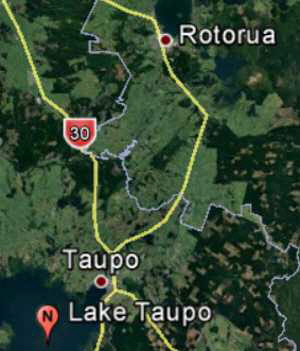To Rotorua

I woke up at my usual time on our last day at Taupo and went for my normal early morning walk along the lake. The walkway took me past a spot in the lake that looked a little strange almost as if there was steam rising from the lake! The water was shallow here so I took off my shoes and rolled my geans up and waded into the lake to see what it was. The water was cold but as I approached the area the “steam” was rising the water felt very warm and the sand felt hot. The water was not hot enough to boil and create real steam, but it did appear to be making a small fog like cloud locally above the water. Later when the sun was fully up, when we drove past this “steam” was all gone, but it was obvious to me that this was because of the volcanic nature of the area.
From Taupo we were heading to “Rotorua,” an area known for its hot sulphur springs with all the heating in the houses coming from the ground. The thing about Rotorua is that you smell it long before you actually see the town, so we were prepared for a time where our noses were in for a bad time (at least if we passed wind [farted] no one would notice).
We arrived in Rotorua in time to have lunch, and we felt that while we could smell the sulphur, it was not as bad as we expected. We looked for a motel not far from the main shopping centre and started to explore.
Our first stop was the lake area and the local tourist information centre. It was at the lake that we saw our first Maori War Canoe. These war canoes are the boats that the ancient Maoris used to come to New Zealand, from the islands further north in the Pacific Ocean many years ago. They can be manned by many people and travel long distances, the crew take turns at paddling and sleeping so that there is always no more than half the crew sleeping and no less than half the crew paddling. When they are used for war this method of travelling ensures that there are always fresh fighters.
To protect these canoes they are richly carved with images of brave ancestors, using the same markings as these ancestors had on their faces. Maoris used tattoos to mark their faces and these tattoos were not just random markings to make the Maori look fierce, but were also markings through which, their place wit in the tribe and their families are traced. One side of the face represented their mother’s side and the other represented their father’s side, their own place was also included, this meant that no two face markings were ever the same!
From the lake and the shelter for the war canoe we went to the “Bath House,” an establishment that was built, so that people may come to Rotorua to bathe in the sulphur mud and water to take advantage of the healing properties of the sulphur, but for now we could only see the outside as it was closing!
Copyright
Viewgrant Pty Ltd 2025
Richardsclan
Welcome to Herman and Carolann’s New Zealand Travels